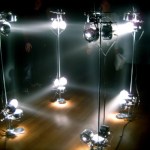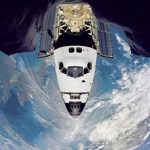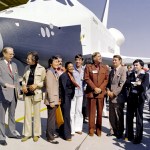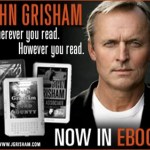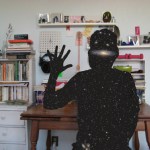Human
I believe the world is a complex phenomenological experience that can be explained, rationalized, and lived in myriad different ways. The way I see it, we all begin with the same fundamental mystery -- why are we here? what is life? -- and we attack this problem with whatever tools we find work best; some of us use science, parsing and decoding the secrets of life with a toolbox of methods and reason. Others, with the same goals in mind, use art, arranging ideas and objects in intentional ways designed to root at the questions of existence. Others still depend on the framework of religion to…
Last week, fresh off the fourth-to-last Shuttle mission, STS-131, NASA astronaut Jim Dutton came to speak at OMSI, my local science museum. When I got the email about this event, I RSVPed immediately -- after all, an astronaut in my town? How urbane. Surely the intelligentsia of Oregon would come in droves to discuss the boggling phenomenological experience of spaceflight and the uncertain future of NASA with one of our nation's "right stuff." As usual, I was wrong; the only adult in the museum unaccompanied by a least one small child, I felt somehow like a pervert, as though the harried…
If it has always been your fantasy to send your physical likeness out into the cosmos, now is your time! To commemorate the final two Shuttle missions, NASA has created a bonkers "Face in Space" initiative, which allows you to upload a picture of yourself to send to the International Space Station. What this actually entails, I imagine, is a burned data DVD in an astronaut's backpack -- nominal space travel if I've ever heard of it.
It's fun, and my face is already destined to launch on September 16th on STS-133; but, seriously, what is this about? Rousing public interest in the space…
As NASA's Space Shuttle program winds down -- Endeavour's final mission is slated for later this year, then that's it -- let us take a moment and remember the Shuttles. Sure, they had a tendency to explode into balls of fire. Sure, they were expensive, risky, and besieged by problems. But now is not the time for criticism: 25 years of American engineering, 132 missions, and over 20,000 orbits of this planet are nothing to shake a stick at. It is in this spirit of recognition that Universe presents a very subjective chronology of the Shuttle's greatest moments. Onward!
Gene Roddenberry, Star…
The North Korean government has made an operating system called "Red Star."
Despite the fact that very few North Koreans have a computer, let alone Internet access, Red Star is designed to provide a safe operating environment in line with North Korean political philosophy of "juche," or self-reliance (as well as, admittedly, monitor user activity).
The Red Star O.S. takes fifteen minutes to install, uses a popular Korean folk song as its start-up music and features a calendar which starts counting time from the birth of Kim Il-sung, making 2010 the year 99. Amazingly, it's Linux-based, with…
A diagram of how the skeletons of Australopithecus sediba came to be preserved in the Malapa cave deposit. From Dirks et al, 2010.
A little less than two million years ago, in what is now South Africa, a torrential downpour washed the bodies of two humans into the deep recesses of a cave. Just how their remains came to be in the cave in the first place is a mystery. Perhaps they fell in through the gaping hole in the cave roof just as hyenas, saber-toothed cats, horses, and other animals had, but, however the humans entered the cave, their bones ultimately came to rest in a natural bowl…
I don't have the attention span to write this article.
In the course of penning this introductory paragraph, I've taken umpteen email breaks, gotten distracted by several Wikipedia wormholes, and taken an hour's time out to watch Frontline documentary clips on YouTube. It has taken me, in toto, seven days to write a five-paragraph article about my generation's decreasing attention span. At least the irony isn't lost on me.
A social researcher tracking my movements across the web might discover that, in the words of University College of London professor and director of CIBER (the Centre…
I'm flying out to New York City on Sunday to participate in the very exciting BRAINWAVE series at the Rubin Museum of Art. BRAINWAVE, which is in its third year, brings thinkers from different disciplines to sit down with scientists to wrap their (and our) minds around the things that matter. Past pairings include Composer Philip Glass and astronomer Greg Laughlin, screenwriter Charlie Kaufman and physicist Brian Greene, and performance artist Laurie Anderson with astrophysicist Janna Levin. Needless to say, it's a fascinating series, and I'm honored to be involved.
I'll be talking with…
In his seminal 1991 essay, "The Work of Art in the Age of Digital Reproduction," the video artist Douglas Davis writes that digital bits "can be endlessly reproduced, without degradation, always the same, always perfect."
This is different, Davis argues, from analogue information. In the past, copying an audio signal -- for example, dubbing a copy of a cassette tape -- always involved an unpredictable loss of clarity, which Davis compares to waves washing on a beach, always breaking slightly differently. But "digital bits, compatible with the new generation of tools that see, hear, speak,…
Photograph by Benjamin Reed.
Ursula K. Le Guin is a internationally-recognized, award-winning science fiction writer, an elegant badass and the author of such classics as the Hugo and Nebula-award winning The Left Hand of Darkness, The Lathe Of Heaven, and the Earthsea novels. Last year, she began mounting formidable opposition to the Google Books Settlement, an inscrutably complex 303-page agreement reached between the Authors Guild, the Association of American Publishers and Google regarding the Web giant's desire to scan the libraries of the world. The Settlement, if approved -- it…
How do we begin?
Well, hello. My name is Claire L. Evans, and I'm new here.
I began writing this blog, Universe in 2005, over at the Portland, Oregon-based web community Urban Honking. At first, it was a vanity project, a noodle, an excuse to keep my grey matter engaged beyond my college years (which were, to say the least, unscientific). In the years since, Universe has taken on various incarnations: briefly as a print column in the now-defunct LA Alternative, which earned me the closest I've ever come to "accolades" (these breezed quickly past), then as a micro-blog for GOOD Magazine.…
Men who think that size really matters should probably not think too hard about the Y chromosome. This bundle of genes is the ultimate determinant of manliness, and it happens to be a degenerate runt. Over a few hundred million years, it has shrunk considerably, jettisoning around 97% of its original genes. Where it was once a large library of genes, now it's more a struggling independent bookstore. This loss of information defined the youth of the Y chromosome but nowadays, things are different. Renovation is the order of the day.
Jennifer Hughes from MIT revealed the recent history…
Whilst they (as Homer's Iliad in a nut)
A world of wonders in one closet shut
-- Inscription on the Tradescant family tombstone, London
There are two things which have deeply terrified me in recent science news. The first, as you may have heard, is that a bumper crop of some 32 "new" planets was discovered by a team of European researchers armed with a spectrograph called HARPS, or High Accuracy Radial velocity Planetary Searcher. The second is that Israeli scientists have made a robot small enough to crawl through human veins.
The offending nanobots.
Why do these things strike horror in…
At first glance, the African elephant doesn't look like it has much in common with us humans. We support around 70-80 kg of weight on two legs, while it carries around four to six tonnes on four. We grasp objects with opposable thumbs, while it uses its trunk. We need axes and chainsaws to knock down a tree, but it can just use its head. Yet among these differences, there is common ground. We're both long-lived animals with rich social lives. And we have very, very large brains (well, mostly).
But all that intelligence doesn't come cheaply. Large brains are gas-guzzling organs and they need…
Today, a new paper published in Nature adds another chapter to the story of FOXP2, a gene with important roles in speech and language. The FOXP2 story is a fascinating tale that I covered in New Scientist last year. It's one of the pieces I'm proudest of so I'm reprinting it here with kind permission from Roger Highfield, and with edits incorporating new discoveries since the time of writing.
The FOXP2 Story (2009 edition)
Imagine an orchestra full of eager musicians which, thanks to an incompetent conductor, produces nothing more than an unrelieved cacophony. You're starting to…
From a young age, children learn about the sounds that animals make. But even without teaching aides like Old Macdonald's farm, it turns out that very young babies have an intuitive understanding of the noises that humans, and even monkeys, ought to make. Athena Vouloumanos from New York University found that at just five months of age, infants match human speech to human faces and monkey calls to monkey faces. Amazingly, this wasn't a question of experience - the same infants failed to match quacks to duck faces, even though they had more experience with ducks than monkeys.
Voloumanos…
In addition to the "missing link" trope that is being dished out about the new primate fossil, is another one, more subtle and insidious: it's the ancestor of all primates. How do they know that? Consider a biologically realistic scenario: at the time there were probably hundreds of species of small bodied mammals with tails and feet like that. One of these species may be the ancestor of all primates, but what are the odds that a specimen from that species is the one that was preserved? Just as all primates now look remarkably similar overall, but one may be the common ancestor of a group in…
It is often the case that when non-academics, or even non-humanities academics, talk about my generic field, they refer to it as "arts", and mean by this the creative arts, like performing arts, crafts, and corporate accounting. So they justify the funding for the "arts" (or "the yartz", as a Barry Humpries character calls them) because we are supposed to entertain people and add to cultural life.
Those who know me know this is not what I do. I have been known to sing in the shower, but that is about it. So I was very pleased to see this piece in the Australian Higher Education section…
In 1976, NASA Administrator James Fletcher noted that "The question, 'What is feasible?' can be finally answered only by future historians." He was talking about the elaborate plans for space habitats the agency had spent a summer noodling over, but the same remark could have been made to the incredulous before the first moon landing, for example -- or before the birth of transoceanic voyages in the 14th and 15th Centuries.
So begins of one of my favorite pieces of utopist NASA detritus, a document called Space Settlements: A Design Study, made over the course of a 10-week workshop at the…
Universe has a firm "No Skepticism" policy.
Don't get me wrong, I dig empirical knowledge. And I like the ancient, Pyrrhonian school of Skepticism founded by Pyrrho of Elis (365-275 B.C.); Pyrrhonian skeptics believed that nothing could be known, not even "this" (i.e the very statement that nothing could be known) and strived for a constant state of inquiry as a source of pleasure. Since absolute knowledge is unattainable, the Pyrrhonian Skeptics felt that their end was: "In opinionatives, indisturbance; in impulsives, moderation; and in disquietives, suspension," which is essentially…
